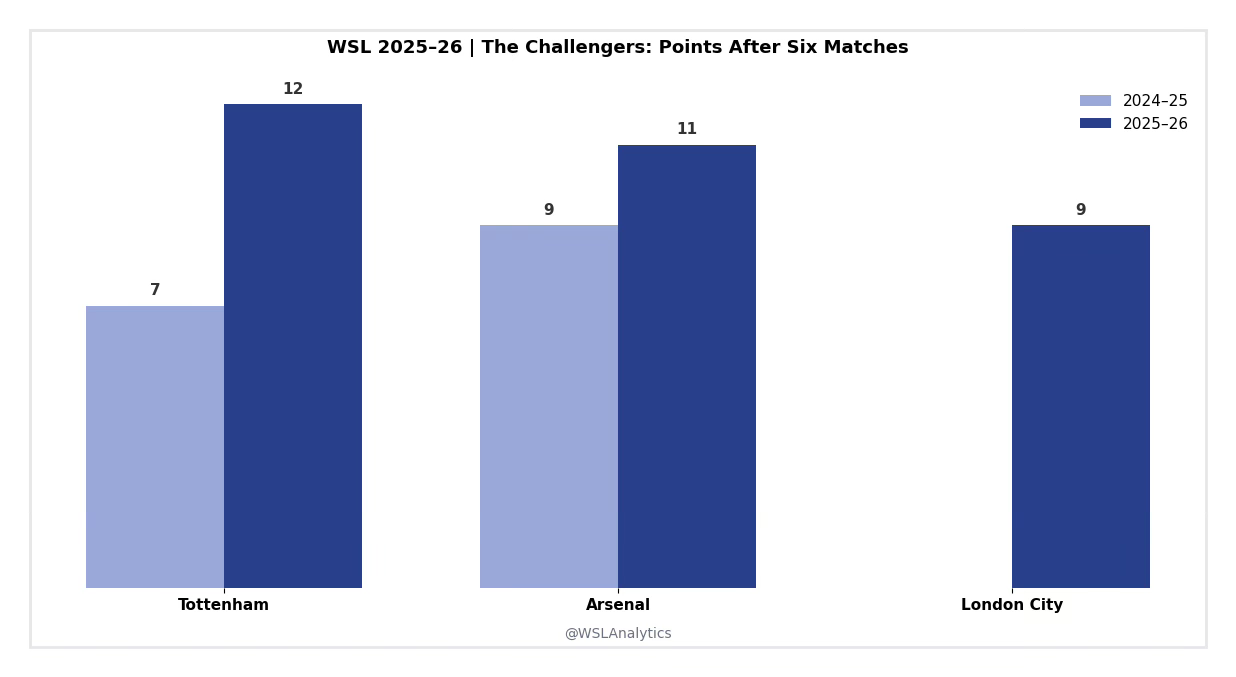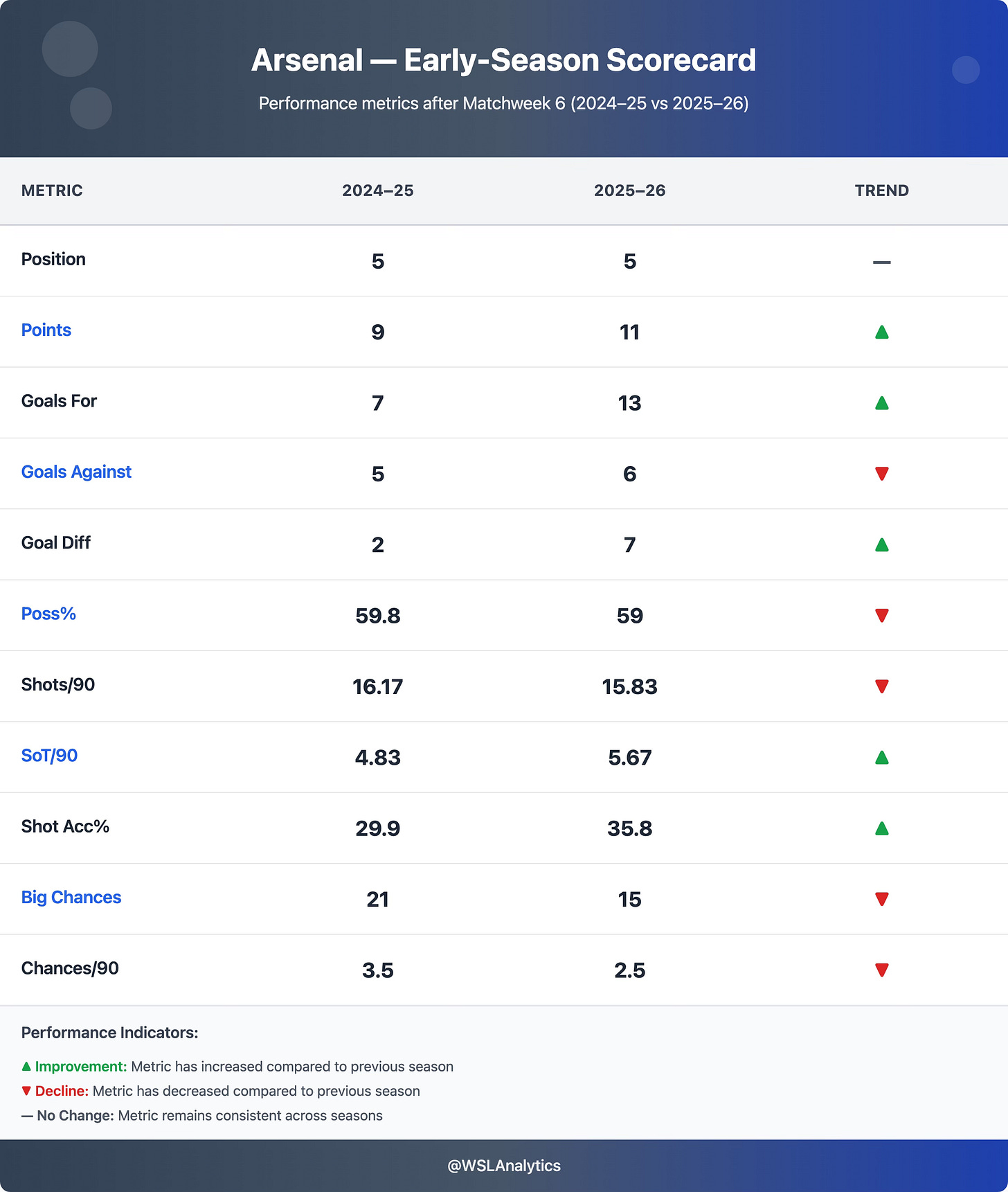State of the League Report – Part 2: WSL 2025–26 Title Race – The Challengers.
Tottenham’s defensive rebirth, Arsenal’s controlled resurgence, and London City Lionesses’ fearless debut reshape the league’s middle order.
Introduction
After analysing the title front-runners in Part 1 – Chelsea, Manchester City, and Manchester United, the focus now shifts to the chasing pack: the sides redefining what sits just below the elite.
Tottenham’s pragmatic transformation, Arsenal’s attempt to rediscover fluency, and London City Lionesses’ unexpectedly mature debut highlight how volatile the league’s middle has become.
This second tier is the WSL’s swing zone. They are capable of denting title bids one weekend and dropping unexpected points the next.
As Europe’s qualifying race intensifies, every marginal gain in structure, balance, and mentality will matter.
The Challengers
Tottenham Hotspur (7th in 2024–25, 4th in 2025–26)
Pragmatic pivot: tighter back line, leaner attack, better results.
Tottenham represent one of the season’s most remarkable turnarounds, climbing from 7th place (7 points) to 4th (12 points) through a defensive revolution that has fundamentally altered their identity.
Defence transformed. Spurs have halved their goals conceded from 14 to 7 (–50%) across the opening six games. The improvement lifts their goal difference from –2 to 0, turning last season’s leaky profile into a far steadier baseline.
Attack scaled back but more selective. Tottenham’s goal output has fallen from 12 to 7 (–42%), with chance volume easing across the board. Shots have declined from 85 to 62 (–27%), shots on target from 40 to 26 (–35%), big chances from 13 to 8 (–38%), and chances created from 61 to 38 (–38%). Shot accuracy has also dipped from 47.1% to 41.9% (–5.2 percentage points). The intent is more measured than last season’s end-to-end approach. Fewer waves, fewer turnovers, less chaos.
Control profile: small trade-off. Possession has dipped slightly from 51.5% to 49.0% (–2.5 percentage points). With fewer entries and a calmer tempo, Spurs are conceding some ball share to keep their structure intact. It appears to be a conscious style trade: marginally less territory for a major gain in defensive stability.
Scoreboard payoff. Despite lighter attacking numbers, points have risen from 7 to 12 (+71%), and the record has improved from two wins, one draw and three losses to four wins and two defeats. By trimming volatility and shoring up the back, Spurs have raised both their floor and their league position.
Data verdict: Tottenham look materially sturdier. A defence-first recalibration that is converting into wins. If they can recover even a slice of last year’s attacking volume (shots 85 to 62, big chances 13 to 8) without loosening the back door, they are built to sustain a top-four pace deep into autumn.
Arsenal (5th in 2024–25, 5th in 2025–26)
Sharper in attack, steady at the back, but still short of title contenders rhythm.
Arsenal have engineered a moderate but meaningful improvement from last season’s sluggish start, rising from 9 points to 11 while maintaining their possession-dominant identity.
Attacking revival. Arsenal’s goal output has almost doubled from 7 to 13 (+86%), reflecting a more effective forward line. They have 11 points from six matches (3-2-1), up from 9 at this stage last season. Overall volume has held steady: about 16 shots per match, comparable with Chelsea’s creative output. Big chances have dipped from 21 to 15 (–29%), but finishing has clearly improved as shot accuracy has risen from 29.9% to 35.8% (+5.9 percentage points).
Possession persistence. Arsenal remain a high-possession side, averaging 59% this season (virtually unchanged from 59.8% last year). The style is still patient build-up with coordinated pressing, aiming to dictate tempo rather than react.
Defensive stability. Arsenal have conceded six goals, up slightly from five at this stage last season. They have two clean sheets so far (one fewer than last year), yet their goal difference has improved from +2 to +7 – a sign of a disciplined back line paired with a sharper attack.
Integration and cohesion. The key integration storyline is new £1 million signing Olivia Smith. Her introduction has been gradual, 350 minutes so far, as she adapts to Arsenal’s structure and rhythm. She has one goal from 11 shots, with shot accuracy at 27.3%, down from 35.0% across 436 minutes at the same stage last season. As her minutes rise and chemistry with the front line builds, Smith should help turn Arsenal’s sustained possession into higher-quality final actions.
Data verdict: Arsenal look more balanced and productive than last autumn. They are converting more of their dominance into goals while keeping a stable defensive platform. To re-enter the title contender conversation, however, they must sustain efficiency and turn possession into decisive results.
London City Lionesses (Newly Promoted, 6th in 2025–26)
Fearless newcomers with composure, conviction, and clear identity.
Newly promoted London City Lionesses have delivered the season’s most pleasant surprise, sitting mid-table with nine points and proving they belong at WSL level from day one.
Exceeding expectations. London City Lionesses have been the surprise package of the season, collecting nine points from six matches (three wins, three defeats) to sit comfortably in mid-table. Their early consistency already surpasses that of last year’s promoted side, Crystal Palace, who managed only four points at the same stage.
Creative competence. The Lionesses average 49% possession and 10.8 shots per match, indicating ambition to play, not just survive. They have generated 48 chances and 15 big chances, comparable to Brighton and on par with Arsenal’s big-chance creation – a level of tactical organisation rare for a newly promoted team. Their shot accuracy of 33.8% signals room for improvement, but the underlying structure already supports chance creation from multiple sources.
Growing pains. Defensive solidity remains a work in progress: 14 goals conceded across six games leaves a goal difference of –7. While not alarming for a first-year WSL side, the margins highlight the adjustment still underway. Within that context, a balanced 3-0-3 record is an achievement in itself.
Data verdict: London City have adapted impressively to top-flight pace. If they can tighten the defensive line and add a more ruthless edge in front of goal, they have every chance to establish themselves securely in the division – a refreshing sign that promotion no longer guarantees a relegation fight.
Conclusion – The Shape of the Chase
The picture beneath the top three is defined by refinement rather than chaos.
Tottenham have traded flair for structure and reaped dividends.
Arsenal are edging back toward their high-control, high-output archetype.
London City Lionesses, fearless and organised, have injected fresh energy into the league’s middle ground.
Together, they form the connective tissue of a season where no tier feels fixed.
Momentum swings weekly; efficiency and defensive control are the new currencies of progress.
Next: In Part 3 of our State of the League Report, we will examine the The Mid-Table Shake-Ups & Survival Picture – How Brighton, Aston Villa, West Ham, and others are fighting for stability.
If this breakdown was useful, please consider subscribing and sharing – and join the conversation on X (Twitter) @WSLAnalytics for live WSL insights all weekend.





